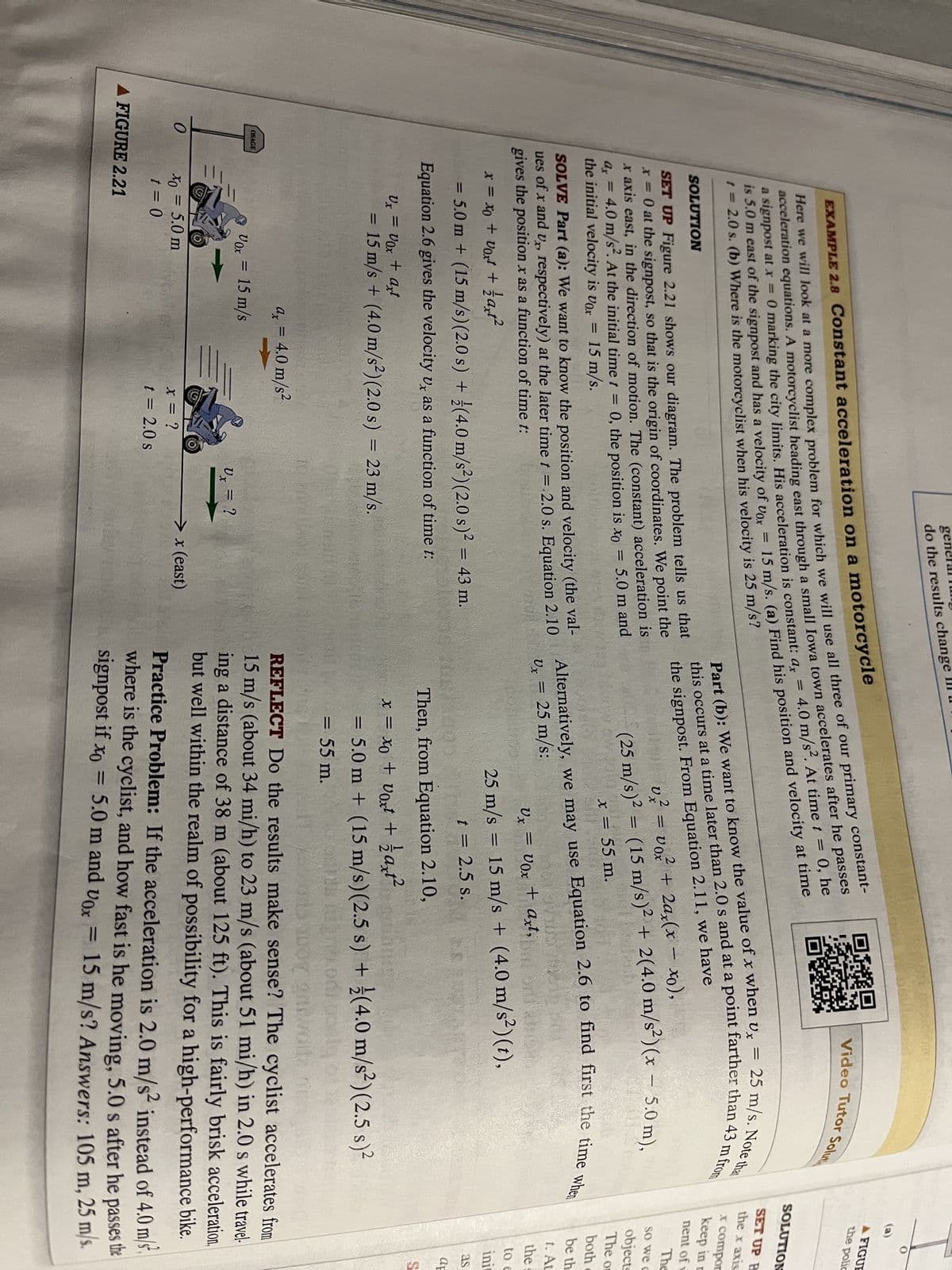Practice Problem: If the acceleration is 2.0 m/s² instead of 4.0 m/s. where is the cyclist, and how fast is he moving, 5.0 s after he passes the signpost if xo = 5.0 m and vox 15 m/s? Answers: 105 m, 25 m/s. =
Practice Problem: If the acceleration is 2.0 m/s² instead of 4.0 m/s. where is the cyclist, and how fast is he moving, 5.0 s after he passes the signpost if xo = 5.0 m and vox 15 m/s? Answers: 105 m, 25 m/s. =
Glencoe Physics: Principles and Problems, Student Edition
1st Edition
ISBN:9780078807213
Author:Paul W. Zitzewitz
Publisher:Paul W. Zitzewitz
Chapter3: Accelerated Motion
Section3.3: Free Fall
Problem 45PP
Related questions
Question
100%
I just need the practice problem solved with work shown. The rest of the image provides the information needed to solve the problem. The correct answer is also provided to check work.

Transcribed Image Text:OSAGE
O
EXAMPLE 2.8 Constant acceleration on a motorcycle
Here we will look at a more complex problem for which we will use all three of our primary constant-
acceleration equations. A motorcyclist heading east through a small Iowa town accelerates after he passes
a signpost at x = 0 marking the city limits. His acceleration is constant: ax =
4.0 m/s². At time t = 0, he
is 5.0 m east of the signpost and has a velocity of vox = 15 m/s. (a) Find his position and velocity at time
1 = 2.0 s. (b) Where is the motorcyclist when his velocity is 25 m/s?
SOLUTION
SET UP Figure 2.21 shows our diagram. The problem tells us that
x = 0 at the signpost, so that is the origin of coordinates. We point the
x axis east, in the direction of motion. The (constant) acceleration is
a = 4.0 m/s². At the initial time t = 0, the position is xo = 5.0 m and
the initial velocity is vox = 15 m/s.
SOLVE Part (a): We want to know the position and velocity (the val-
ues of x and Ux, respectively) at the later time t =.2.0 s. Equation 2.10
gives the position x as a function of time t:
x = xo + voxt + 1/a,t²
= 5.0 m+ (15 m/s) (2.0 s) + (4.0 m/s²) (2.0 s)² = 43 m.
Equation 2.6 gives the velocity Ux as a function of time t:
Ux = Vox + axt
= 15 m/s + (4.0 m/s²) (2.0 s) = 23 m/s.
Vox
xo = 5.0 m
t = 0
FIGURE 2.21
=
ax = 4.0 m/s²
gen
do the results change
15 m/s
X = ?
t = 2.0 s
TO
Ux = ?
→ x (east)
Video Tutor Solut
25 m/s. Note that
this occurs at a time later than 2.0 s and at a point farther than 43 m from
Part (b): We want to know the value of x when ux
the signpost. From Equation 2.11, we have
=
2
v² = voz² + 2ax(x − xo),
Ux
(25 m/s)² = (15 m/s)2 + 2(4.0 m/s²)(x - 5.0 m),
x = 55 m.
Alternatively, we may use Equation 2.6 to find first the time when
Ux = 25 m/s:
Ux = Vox + axt,
25 m/s = 15 m/s + (4.0 m/s²)(t),
t = 2.5 s.
Then, from Equation 2.10,
x = xo + voxt + 1⁄2 axt²
=
= 5.0 m+ (15 m/s) (2.5 s) + (4.0 m/s²) (2.5 s)²
= 55 m.
sors Rigodi pol
oniworla
A FIGUE
the polic
SOLUTION
SET UP B
the x axis
x compor
keep in m
nent of
The
so we c
objects
The or
both
be th
t. At
the
to E
ini
as
aF
REFLECT Do the results make sense? The cyclist accelerates from
15 m/s (about 34 mi/h) to 23 m/s (about 51 mi/h) in 2.0 s while travel-
ing a distance of 38 m (about 125 ft). This is fairly brisk acceleration,
but well within the realm of possibility for a high-performance bike.
Practice Problem: If the acceleration is 2.0 m/s² instead of 4.0 m/s.
where is the cyclist, and how fast is he moving, 5.0 s after he passes the
signpost if xo = 5.0 m and vox = 15 m/s? Answers: 105 m, 25 m/s.
Expert Solution
This question has been solved!
Explore an expertly crafted, step-by-step solution for a thorough understanding of key concepts.
This is a popular solution!
Trending now
This is a popular solution!
Step by step
Solved in 3 steps

Knowledge Booster
Learn more about
Need a deep-dive on the concept behind this application? Look no further. Learn more about this topic, physics and related others by exploring similar questions and additional content below.Recommended textbooks for you

Glencoe Physics: Principles and Problems, Student…
Physics
ISBN:
9780078807213
Author:
Paul W. Zitzewitz
Publisher:
Glencoe/McGraw-Hill

Glencoe Physics: Principles and Problems, Student…
Physics
ISBN:
9780078807213
Author:
Paul W. Zitzewitz
Publisher:
Glencoe/McGraw-Hill